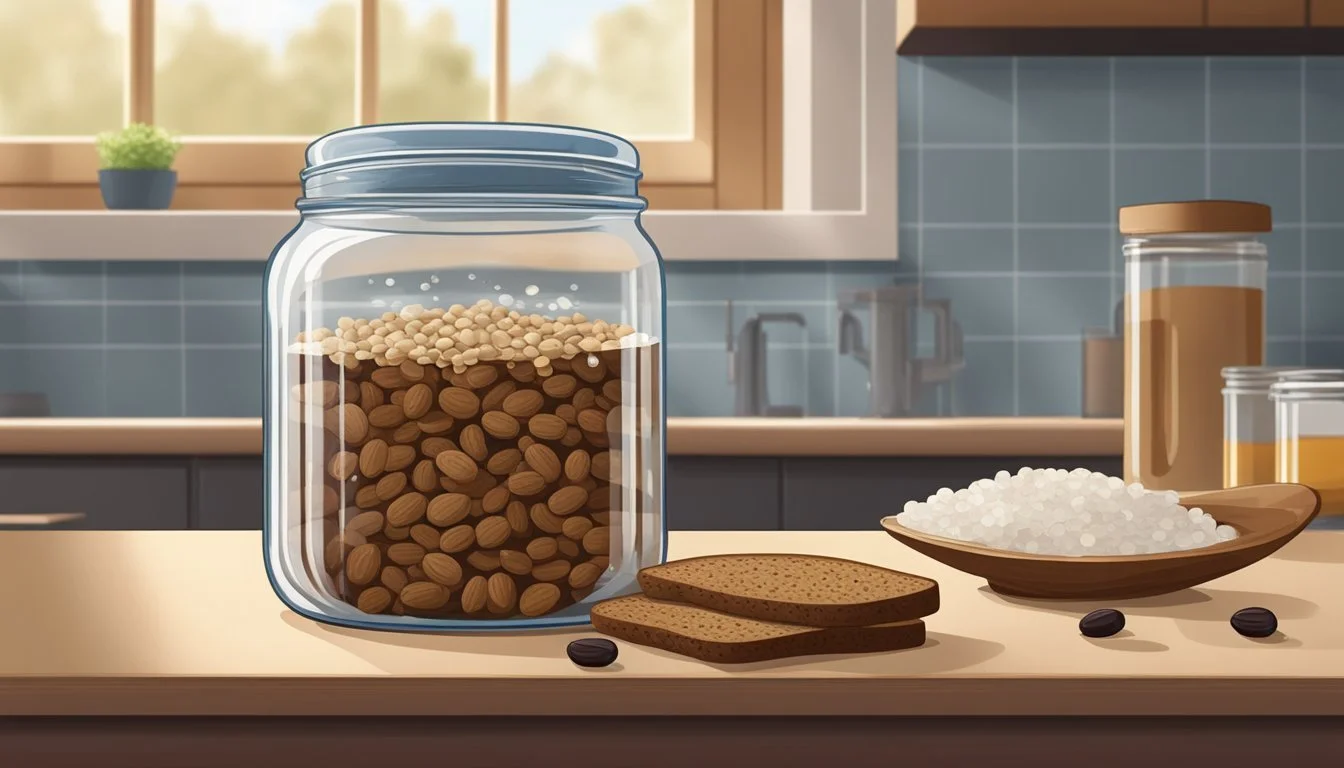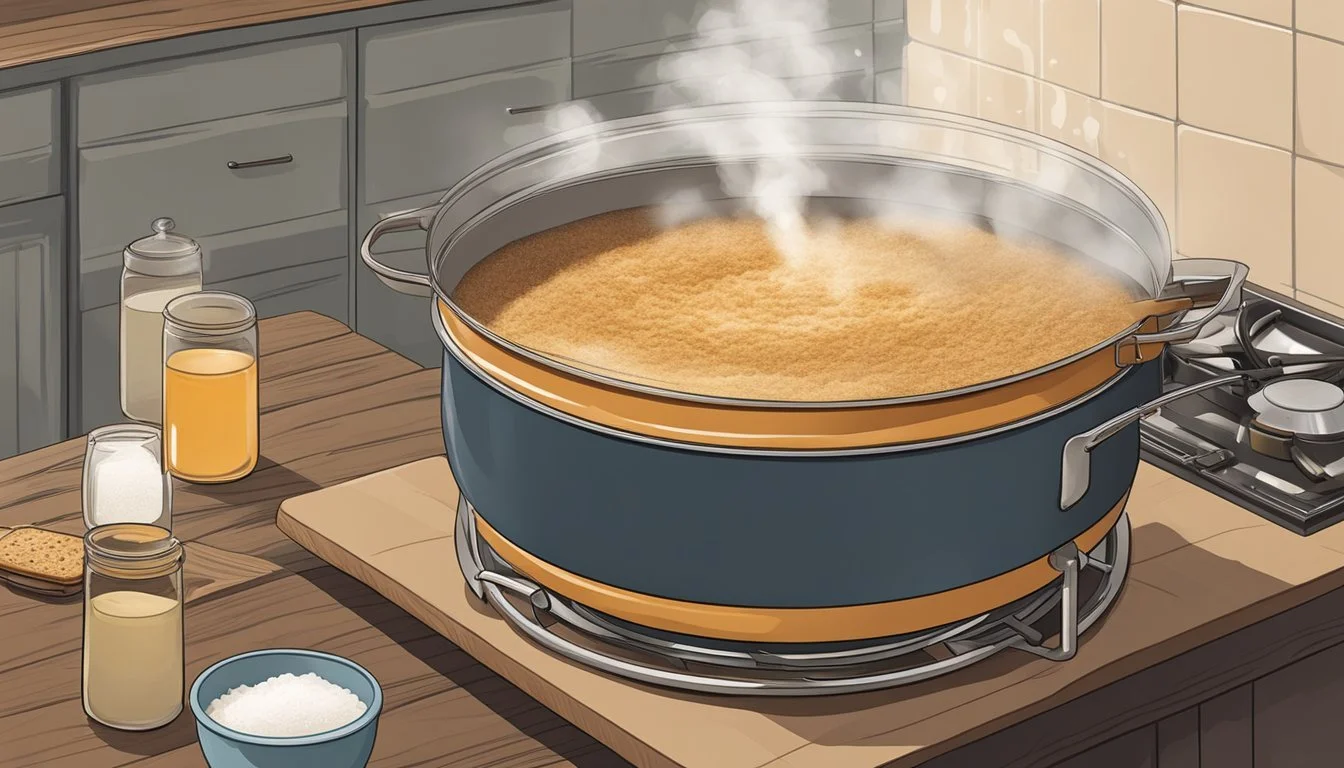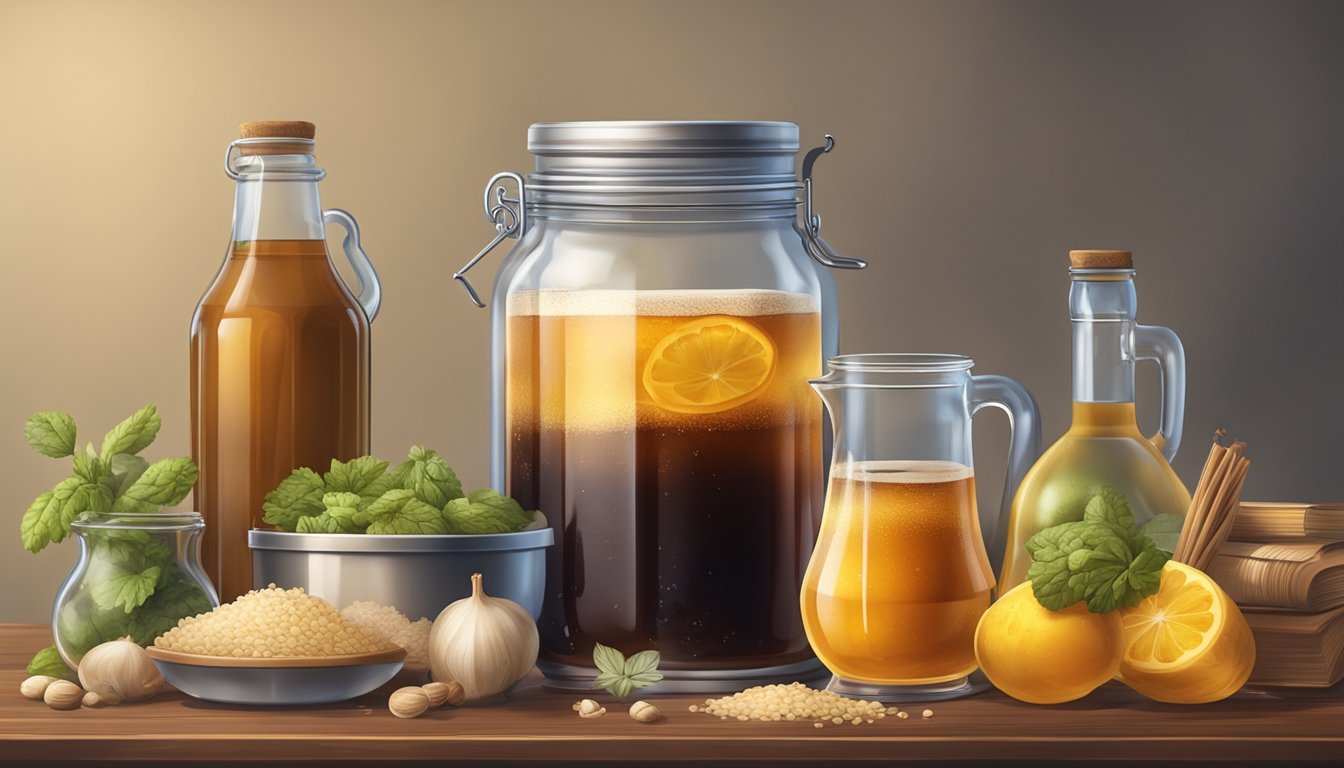How to Ferment Kvass
Mastering the Traditional Russian Beverage
Kvass is a traditional fermented beverage hailing from Russia and Eastern Europe with a history that runs deep through the cultural fabric of these regions. This mildly alcoholic drink is rooted in the ancient Slavic communities and has been enjoyed for its unique taste and purported health benefits. It typically features a sour, earthy profile and is often compared to beer, although it is usually less potent in alcohol content. Kvass is made predominantly from black or rye bread (What wine goes well with bread?) which provides the fermentable sugars necessary for the process.
The method of fermenting kvass involves a symbiosis of yeast and bacteria, which collaborate to convert the sugars from the bread into alcohol and various flavor compounds. Throughout its history, kvass has maintained popularity due to its ease of production and the simple, readily available ingredients involved. In Russia and surrounding countries, it's not uncommon to find kvass as a refreshing drink on a warm day, sold from dedicated street carts or in stores.
The fermentation process of kvass allows for a range of creativity in terms of flavors, bridging tradition and modern tastes. While classic kvass is made with rye bread, it can also be crafted with fruits, raisins, or additional flavors like honey or herbs, catering to a wider palate. This versatility keeps kvass relevant in the contemporary beverage scene, allowing enthusiasts and newcomers alike to appreciate this age-old refreshment.
History and Cultural Significance
Kvass has a storied past that intertwines with the culinary and cultural traditions of Eastern Europe. This traditional Russian drink, often referred to as "bread in a bottle," reveals a history that dates back centuries and a cultural importance that transcends its humble ingredients.
Origins of Kvass
The inception of kvass is generally traced to Eastern Europe, where it has served as a staple beverage for many generations. Although kvass is closely associated with Russia, historical references suggest its antecedents existed in civilizations as ancient as Ancient Greece and Ancient Egypt. For instance, a drink known as 'Zyphos' shares similarities with kvass and was mentioned by the Greek historian Herodotus as early as the 5th century BC. The first documented mention of kvass within what is now Russia appears in the Primary Chronicle, which describes a feast celebrating Vladimir the Great's baptism in the year 996.
Kvass in Eastern European Culture
Kvass has ingrained itself deeply in Eastern European culture, particularly in Russia, where it is considered not only a beverage but a symbol of traditional cuisine. Its cultural significance is evident as it has been enjoyed by people from every social stratum, from peasants to tsars. Kvass is not just a refreshing drink; it also had a role in religious rituals and festivities, underscoring its impact on social and cultural practices in Eastern Europe. The beverage's connection to bread, a staple of the Russian diet, further highlights its cultural resonance, as kvass is often made by fermenting rye bread. Today, kvass remains a popular drink, emblematic of Eastern European hospitality and culinary heritage.
Understanding Fermentation
In Kvass production, fermentation is a critical process where yeast transforms sugars into alcohol and carbon dioxide, producing a tangy, effervescent beverage with probiotic qualities beneficial to gut health.
Fermentation Process Explained
The fermentation process in Kvass starts when yeast and beneficial bacteria metabolize the sugars present in the ingredients, primarily from malted bread. This metabolic action results in the production of ethanol and carbon dioxide, giving Kvass its signature fizz. During this stage, a complex array of flavors develops, and some probiotic bacteria can contribute to the overall fermented profile of the beverage.
The process typically goes as follows:
Sugars in malted bread are extracted into water.
Yeast, often alongside sugar, is added to the sugary liquid.
The mixture is left to ferment, whereby yeast consumes the sugars.
Alcohol and carbon dioxide are produced during metabolism.
Role of Yeast and Bacteria
Yeast plays an essential role in Kvass fermentation, acting as the primary catalyst by converting sugars into alcohol and carbon dioxide. Certain strains of yeast can also impart unique flavors to the Kvass.
The critical functions of yeast and bacteria in Kvass fermentation include:
Yeast: Initiates the fermentation by breaking down sugars.
Probiotic Bacteria: Can develop during fermentation, contributing to the healthful properties and complex taste of the beverage. They are known to be advantageous for gut health.
It's important to control the fermentation environment to ensure a successful transform of the base ingredients into a flavorful, carbonated, and probiotic-rich Kvass.
Essential Ingredients
The quality of ingredients in kvass fermentation is crucial to achieving the desired taste and proper fermentation. Bread, water, and sweeteners are the foundations, each contributing to the beverage's unique character.
Choosing the Right Bread
The bread is the soul of kvass, providing the fermentable sugars and distinct flavor. Rye bread is traditionally used due to its dense, flavorful nature that imparts a rich taste. It's important to use stale or toasted rye bread to maximize flavor extraction during the fermentation process.
Water Quality and Its Effects
Water acts as the solvent for kvass, so its quality cannot be overstated. Chlorine-free, filtered water is ideal as it will not inhibit the fermentation process or introduce off-flavors. The temperature of the water should be lukewarm to optimize the fermentation environment.
Sweeteners and Flavorings
Sweeteners are not only a source of food for the fermenting yeast but also balance the sourness with sweetness. Sugar is commonly used, but some recipes call for fruits like raisins or other sweeteners for additional flavors. Flavorings, such as herbs or fruit slices, can also be added to create unique variations of kvass. The choice of sweeteners and flavorings personalizes the recipe and can significantly impact the final product.
Preparing the Kvass Base
The preparation of the Kvass base is a critical step where the flavors begin to develop and the fermentation process is initiated. One starts with a foundation of rye bread to create a sweet, fermented beverage, following either a traditional recipe or opting for variations that incorporate different ingredients such as beets or lemon.
Traditional Kvass Recipe
First, rye bread is the traditional cornerstone of Kvass. It should be toasted to enhance its flavor and malted sugars. Here is a simple process:
Cube the rye bread.
Toast the cubes until they are deep brown and crispy.
Place the toasted bread in a container, such as a large bowl.
Pour boiling water over the bread, ensuring it is fully submerged.
Allow the mixture to soak for a range from 4 to 24 hours.
After soaking, strain the liquid to remove the bread solids.
At this stage, one adds sugar—which could be common white sugar—to sweeten the beverage and help the fermentation process. Yeast is also introduced (either commercial bread yeast or a natural sourdough starter) to begin the fermentation. The mixture should then be left in a warm place to start fermenting.
Alternative Kvass Variations
For those seeking variation, different ingredients can be added to the base for diverse flavors:
Beet Kvass: Substitute the bread with chopped beets. This variation often includes a touch of salt and is known for its earthy flavor and probiotic qualities.
White Rye Flour Kvass: Use scalded white rye flour mixed with a bit of cold water as the fermentation base instead of bread.
Flavor Variations: Additions like lemon zest or juice can introduce a citrus note.
For each variation, one generally follows the same principle: mix the key ingredient with water, add sweetness and yeast, then allow the mixture to ferment. The exact quantities and durations may vary depending on the specific recipe and desired outcome.
The kvass base preparation sets the stage for fermentation, which will later be followed by bottling and a secondary fermentation period for those looking to achieve carbonation in their homemade Kvass.
The Fermentation Stage
The fermentation stage is crucial in producing Kvass as it transforms the sweet liquid extracted from bread into a mildly alcoholic fermented drink with its unique taste.
Setting Up for Fermentation
To start the fermentation process, one needs a clean fermentation container. It can be a mason jar for small batches or a specialized fermentation vessel for larger volumes. The sweet liquid, previously extracted from the bread and mixed with sugar and yeast, is poured into the container. For flavor complexity, additional ingredients like fruit, herbs, or spices can also be added at this point. This mixture should be left, covered, at room temperature which typically ranges between 20°C (68°F) to 26°C (78°F).
Materials Needed:
Fermentation container (mason jar or specialized vessel)
Strained liquid from bread
Sugar
Yeast
Additional flavoring ingredients (optional)
Monitoring Fermentation Progress
Regular checks should be performed during the fermentation period, which usually spans from 24 hours to one week, depending on desired sweetness and alcohol content. The mixture will start to show signs of fermentation, such as bubbling and changes in smell. After initial active fermentation slows, the Kvass can be bottled, leaving some space at the top of the bottle to allow for carbonation.
Steps for Monitoring:
Visual Inspection: Look for bubbles and froth formation.
Smell: Notice changes indicating fermentation (yeasty, beery).
Taste Test: To determine if the Kvass has reached the desired taste profile.
Once bottled, the Kvass should be left to carbonate for an additional 2-3 days. After this secondary fermentation period, the bottles could be transferred to a refrigerator, which slows the fermentation process and helps to condition the flavor. The finished Kvass should be enjoyed cold and is typically low in alcohol content, though time and yeast used will ultimately determine its potency.
Flavoring and Customizing Kvass
When fermenting kvass, personalizing the flavor profile to suit one’s taste is an integral part of the process. By adding fruits, herbs, and adjusting the levels of sweetness and sourness, one can create a unique and enjoyable beverage.
Adding Fruits and Herbs
To infuse kvass with natural flavors, a variety of fruits and herbs can be added during the fermentation process. Commonly used fruits include apples, berries, and raisins. These not only contribute to the flavor but can also affect the color and aroma of the final product. For a more herbal taste, mint or other herbs can be incorporated, which can be especially refreshing during the warmer months. The addition of lemon peel can impart a citrus edge that brightens the kvass.
Fruits: Apples (cubed), Berries (handful), Raisins (1/4 cup)
Herbs: Mint (5-6 leaves), Lemon Peel (1 tbsp)
Adjusting Sweetness and Tartness
The balance of sweetness and tartness is crucial in kvass, and it can be adjusted according to personal preference. To increase sweetness, one might add honey or more sugar in the initial stages of fermentation. It's important to note that the sweetness level may decrease as fermentation progresses because the yeasts consume the sugars. Conversely, to enhance tartness, adjust the amount of sourdough starter if used, or the length of the ferment, as a longer ferment typically results in a tarter kvass.
To sweeten: Honey (1-3 tbsp, to taste)
To tart: Sourdough starter (1/4 cup), Extend fermenting time
By experimenting with these additions, the fermenter can develop a kvass that is perfectly tailored to their palate.
Bottling and Storage
After fermentation, the key to preserving Kvass lies in proper bottling and storage, ensuring it remains flavorful and carbonated.
Filtration and Bottling Techniques
Before bottling, one should strain the Kvass using a fine mesh strainer to remove any solid bread particles or added flavorings. The liquid should be poured carefully into clean glass jars or flip-top glass bottles, leaving about an inch of space at the top to allow for carbonation buildup. This headspace is critical to prevent bottles from bursting.
Strain: Utilize a fine mesh strainer to clarify the Kvass.
Glass Jars/Bottles: Choose appropriate, sanitized containers for bottling.
Head Space: Leave an inch free at the top of the container for gas expansion.
Optimal Storage Conditions
Once bottled, Kvass must be stored in a refrigerator to slow down any further fermentation, thereby preserving its taste and preventing over-carbonation. The cool temperature ensures that the Kvass retains its fizz while also reducing the risk of spoilage.
Refrigeration: Store Kvass at cold temperatures immediately after bottling.
Monitor Fizz: Check containers periodically for excess carbonation to prevent bursting.
By adhering to these steps, one ensures that their Kvass is bottled correctly and stored in conditions that maintain its quality and flavor.
Serving and Enjoyment
When serving homemade kvass, one should consider the desired balance between its intrinsic sweet and tangy flavors and the level of fizz. Proper serving enhances kvass as a refreshing drink.
Serving Suggestions
Kvass is traditionally served cold to underscore its refreshing quality. For optimal enjoyment, one might chill the fermented beverage in the refrigerator before serving. It is customary to serve kvass in clear glasses to showcase its unique color and carbonation. Adding a few ice cubes can further enhance its refreshing nature, but one should be mindful not to dilute the drink excessively.
The alcohol content in kvass is typically low, usually under 2.5%, which makes it suitable for a broader audience, including those who prefer beverages with minimal alcohol. The fizz in kvass, a result of natural carbonation during fermentation, should be evident upon pouring, offering a sensory anticipation of the beverage's crisp mouthfeel.
Pairing with Foods
Kvass pairs well with a variety of foods, often complementing traditional Eastern European dishes:
Appetizers: Kvass can be a palate cleanser alongside hearty appetizers such as pickles or smoked fish.
Main Courses: Its tangy taste contrasts well with rich and savory dishes, such as stews or roasts.
Salads: A light salad with a vinaigrette dressing can be complemented by kvass's sweet undertones.
One should avoid pairing kvass with overly sweet desserts, as its sweetness is subtle and could be overwhelmed by more sugary flavors. Instead, it may complement fruit-based desserts (What wine goes well with fruit-based desserts?) or cheese platters, where its effervescence and tang can balance the creaminess of the cheeses.
Health Benefits and Nutritional Information
Kvass, a traditional fermented beverage, has been recognized for its beneficial properties, particularly concerning digestive health and its nutritional value. This drink provides probiotics and a range of vitamins and minerals essential for bodily functions.
Probiotics and Digestive Health
Kvass contains probiotics, which are live microorganisms that promote a healthy gut microbiota. These probiotics aid in digestion, support the absorption of nutrients, and help maintain the integrity of the gut barrier. Regular consumption of Kvass can contribute to balancing the digestive system and alleviating issues such as bloating and constipation.
Vitamins and Minerals Content
This fermented beverage is not only low in calories but also a good source of various minerals and vitamins, including:
Magnesium: Important for muscle and nerve function.
Potassium: Essential for maintaining fluid balance and proper cell function.
Iron: Crucial for oxygen transport in the blood.
Furthermore, Kvass typically contains a spectrum of B vitamins, notably vitamin B12, which is vital for red blood cell formation and the functioning of the nervous system. The fermentation process may enhance the bioavailability of these nutrients, making them more accessible for the body to use.
Common Questions and Troubleshooting
In fermenting Kvass, enthusiasts often encounter issues relating to the fermentation process and flavor profiles. This section offers practical guidance for addressing these challenges.
Handling Kvass Fermentation Issues
Stalled Fermentation: If fermentation does not begin within 1-2 days, ensure the environment is warm enough, usually between 68-75°F, and check that the yeast is still active. If required, one may need to add a fresh batch of yeast to restart the process.
Overactive Fermentation: In cases where fermentation is too vigorous, it may be necessary to release some pressure from the fermentation vessel. Make sure the vessel is not in an overly warm area. A cooler location might slow down the activity.
Addressing Flavor Imbalances
Too Tangy or Sour Kvass:
Reduce fermentation time.
Add less starter or yeast in the next batch to slow down the fermentation rate.
Insufficiently Sweet Kvass:
Increase the amount of sweeteners like sugar or honey in the recipe.
Adjust the soaking time of the bread to extract more sugars.
Balancing the flavors in Kvass involves careful control of the ingredients and understanding the fermentation process. Changes should be made incrementally to refine the desired taste profile.
Advanced Techniques and Experiments
This section delves into the different ways one can enhance the traditional kvass recipe by experimenting with various ingredients and preparation methods.
Experimenting with Kvass Recipes
Those with experience in kvass making should consider experimenting with the addition of fruits such as berries, apple, or even ginger. These ingredients can be infused during the initial fermentation or added after the primary fermentation is complete to steep during the secondary fermentation. To incorporate fruits, one can follow these general steps:
Primary Fermentation: Add chopped or mashed fruits (berries, apple pieces, or ginger slices) to the initial ferment to imbue the kvass with their flavors.
Secondary Fermentation: For a subtler taste, add the fruits after straining the initial ferment, then allow to ferment a second time for deeper flavor complexity.
Creating Your Own Kvass Variations
When creating a homemade kvass recipe, one has the flexibility to experiment with different types of grains or bread such as rye, wheat, or even specialty grains. Each grain will impart a unique flavor profile to the kvass. Incorporating different sweeteners such as honey or molasses can also alter the taste. Here's what to keep in mind:
Grains: Using a variety of grains will affect the taste and color of the kvass. Wheat will give a lighter flavor, while rye will result in a richer, darker brew.
Sweeteners: Experiment with replacing sugar with honey, maple syrup, or molasses for a different sweetness level and an additional layer of flavor.
By combining these techniques, enthusiasts can fine-tune their kvass to personal taste preferences, exploring a wide spectrum of flavors and textures.








